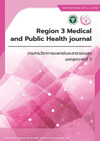ผลของยา Dexmedetomidine ต่อการตอบสนองของอัตราการเต้นของหัวใจและความดันโลหิต สำหรับการระงับความรู้สึกผ่าตัดบายพาสเส้นเลือดหัวใจ: การศึกษาแบบสุ่มมีกลุ่มควบคุมปกปิดสองทาง
คำสำคัญ:
Dexmedetomidine, การใส่ท่อหายใจ, การลงมีดผ่าตัด, การตัดกระดูก Sternumบทคัดย่อ
วัตถุประสงค์: เพื่อศึกษาผลของยา Dexmedetomidine ร่วมกับการระงับความรู้สึกสำหรับผ่าตัดบายพาสเส้นเลือดหัวใจ ต่ออัตราการเต้นของหัวใจและความดันโลหิตในช่วงใส่ท่อหายใจ ลงมีดผ่าตัด และตัดกระดูก Sternum และศึกษาปริมาณยา Nicardipine ที่ใช้เพื่อลดความดันซิสโตลิกให้ได้ 80-90 มิลลิเมตรปรอท ก่อนใส่ Aortic Cannulation เปรียบเทียบกับกลุ่มควบคุม
วิธีการศึกษา: เป็นการวิจัยเชิงทดลองแบบสุ่มชนิดมีกลุ่มควบคุมโดยมีการปกปิดข้อมูลทั้งสองทาง (Randomized double-blind controlled trial) ในผู้ป่วย อายุ 40-75 ปี, ASA Physical Status II-III ที่มารับการผ่าตัดทำบายพาสเส้นเลือดหัวใจ (CABG) ในโรงพยาบาลสวรรค์ประชารักษ์ตั้งแต่เดือนพฤษภาคม พ.ศ.2566 ถึงเดือนธันวาคม พ.ศ.2566 ทั้งหมด 60 คน โดยแบ่งเป็น 2 กลุ่ม กลุ่มละ 30 คน กลุ่ม Dexmedetomidine จะได้รับ รับยาในขนาด 1 ไมโครกรัมต่อกิโลกรัมเป็นเวลา 10 นาทีต่อด้วย 0.5 ไมโครกรัมต่อกิโลกรัมต่อชั่วโมง กลุ่มควบคุมจะได้รับ Normal Saline ในอัตราเร็วที่เท่ากัน ควบคุมความลึกของการสลบให้ได้ BIS 40-50 เปรียบเทียบอัตราการเต้นของหัวใจ ความดันซิสโตลิก ความดันไดแอสโตลิก และความดันโลหิตเฉลี่ยในช่วงใส่ท่อหายใจ ลงมีดผ่าตัดและตัดกระดูก Sternum ขนาดยา Nicardipine เพื่อทำให้ความดันซิสโตลิก 80-90 มิลลิเมตรปรอท ก่อนทำ Aortic Cannulation
ผลการศึกษา: อัตราการเต้นของหัวใจเฉลี่ยของกลุ่ม Dexmedetomidine น้อยกว่ากลุ่มควบคุมทั้งในช่วงหลังใส่ท่อหายใจ 1 นาที (66±12.2 และ 88±19.4) 3 นาที (63±10.8 และ 81±18.4) 5 นาที (61±10.2 และ 77±16.1) หลังลงมีดผ่าตัด1 นาที (63±11.2 และ 85±17.3) 3 นาที (63±12.1และ 81±16.3) 5 นาที (63±10.0 และ 77±17.4) และหลังตัดกระดูก Sternum 1 นาที (66±12.1 และ 81±18.5) 3 นาที ( 65±12.0 และ 76±18.5) ที่ 5 นาที (65±11.1 และ 76±15.8) และมีนัยสำคัญทางสถิติ (p-value<0.01) ความดันซิสโตลิก ความดันไดแอสโตลิก และความดันโลหิตเฉลี่ยทั้งสองกลุ่มไม่มีความแตกต่างกันอย่างมีนัยสำคัญทางสถิติ กลุ่ม Dexmedetomidine ใช้ยา Nicardipine เฉลี่ยเพื่อลดความดันซิสโตลิกให้ได้ 80-90 มิลลิเมตรปรอท น้อยกว่ากลุ่มควบคุมอย่างมีนัยสำคัญทางสถิติ (0.27±0.1 และ 0.5±0.2 มิลลิกรัม: p-value<0.01)
สรุป: Dexmedetomidine มีผลลดอัตราการเต้นของหัวใจในผู้ป่วยที่มารับการผ่าตัดบายพาสเส้นเลือดหัวใจ (CABG) แต่ไม่มีผลลดความดันโลหิตเมื่อเปรียบเทียบกับกลุ่มควบคุม และมีผลลดปริมาณการใช้ Nicardipine เพื่อลดความดันซิสโตลิก ก่อนทำ Aortic Cannulationเมื่อเปรียบเทียบกับกลุ่มควบคุม
คำสำคัญ: Dexmedetomidine, การใส่ท่อหายใจ, การลงมีดผ่าตัด, การตัดกระดูก Sternum
เอกสารอ้างอิง
Pölzl L, Thielmann M, Cymorek S, Nägele F, Hirsch J, Graber M, et al. Impact of myocardial injury after coronary artery bypass grafting on long-term prognosis. Eur Heart J. 2022 Jul 1;43(25):2407–17.
Kapoor MC. Neurological dysfunction after cardiac surgery and cardiac intensive care admission: A narrative review part 1: The problem; nomenclature; delirium and postoperative neurocognitive disorder; and the role of cardiac surgery and anesthesia. Ann Card Anaesth. 2020;23(4):383–90.
Bolus Administration of Esmolol Attenuates Hemodynamic Effects in Adults Undergoing Laryngoscopy and Endotracheal Intubation: Meta-Analysis of Randomized Controlled Trials | International Journal of Medical Science and Clinical Research Studies. 2022 Jul 13 [cited 2024 Apr 12]; Available from: https://ijmscr.org/index.php/ijmscrs/article/view/243
Jalonen J, Hynynen M, Kuitunen A, Heikkilä H, Perttilä J, Salmenperä M, et al. Dexmedetomidine as an anesthetic adjunct in coronary artery bypass grafting. Anesthesiology. 1997 Feb;86(2):331–45.
Ashes C, Judelman S. Myocardial Revascularization. In: Vives M, Hernandez A, editors. Cardiac Anesthesia and Postoperative Care in the 21st Century [Internet]. Cham: Springer International Publishing; 2022 [cited 2024 Apr 12]. p. 199–207. Available from: https://doi.org/10.1007/978-3-030-79721-8_15
Liu X, Li Y, Kang L, Wang Q. Recent Advances in the Clinical Value and Potential of Dexmedetomidine. J Inflamm Res. 2021 Dec 30;14:7507–27.
Kaye AD, Chernobylsky DJ, Thakur P, Siddaiah H, Kaye RJ, Eng LK, et al. Dexmedetomidine in Enhanced Recovery After Surgery (ERAS) Protocols for Postoperative Pain. Curr Pain Headache Rep. 2020; 24(5):21.
Ye Q, Wang F, Xu H, Wu L, Gao X. Effects of dexmedetomidine on intraoperative hemodynamics, recovery profile and postoperative pain in patients undergoing laparoscopic cholecystectomy: a randomized controlled trial. BMC Anesthesiol. 2021 Mar 1;21(1):63.
Ibrahim IM, Hassan R, Mostafa RH, Ibrahim MA. Efficacy of Dexmedetomidine Infusion Without Loading Dose on Hemodynamic Variables and Recovery Time During Craniotomy: A Randomized Double-blinded Controlled Study. Anesthesiol Pain Med. 2021 May 2;11(2):e113410.
Ming S, Xie Y, Du X, Huang H, Fan Y, Liang Q, et al. Effect of dexmedetomidine on perioperative hemodynamics and organ protection in children with congenital heart disease: A randomized controlled trial. Medicine (Baltimore). 2021 Jan 8;100 (1):e23998.
Kamal M, Agarwal D, Singariya G, Kumari K, Paliwal B, Ujwal S. Effect of dexmedetomidine on attenuation of hemodynamic response to intubation, skin incision, and sternotomy in coronary artery bypass graft patients: A double-blind randomized control trial. J Anaesthesiol Clin Pharmacol. 2020; 36(2):255–60.
MENDEZ NG, Reyna GC, Ramírez MJ, Duran RC, Delgado CM, Bravo RM. Drugs For Attenuation of Hemodynamic Responses In Patients Undergoing Elective Off-Pump Coronary Artery Bypass Graft: A Randomized Clinical Tria [Internet]. 2021 [cited 2024 Apr 12]. Available from: https://doi.org/ 10.22541/au.162626890.04351851/v1
Silpa AR, Koshy KA, Subramanian A, Pradeep KK. Comparison of the efficacy of two doses of dexmedetomidine in attenuating the hemodynamic response to intubation in patients undergoing elective cardiac surgery: A randomized double-blinded study. J Anaesthesiol Clin Pharmacol. 2020 Mar;36(1):83.
Weerink MAS, Struys MMRF, Hannivoort LN, Barends CRM, Absalom AR, Colin P. Clinical Pharmacokinetics and Pharmacodynamics of Dexmedetomidine. Clin Pharmacokinet. 2017 Aug;56(8):893–913.
Wujtewicz M, Twardowski P, Jasiński T, Michalska-Małecka K, Owczuk R. Evaluation of the Relationship between Baseline Autonomic Tone and Haemodynamic Effects of Dexmedetomidine. Pharmaceuticals. 2023 Feb 25;16(3):354.
Elgebaly AS, Fathy SM, Sallam AA, Elbarbary Y. Cardioprotective effects of propofol-dexmedetomidine in open-heart surgery: A prospective double -blind study. Ann Card Anaesth. 2020;23(2) :134–41.
Kumar R, Aakanksha, Das AK, Verma NK, Saxena AC, Hoque M. Systemic effects and clinical application of dexmedetomidine. Pharma Innov J. 2020;9(11):241–6.
Seangrung R, Pasutharnchat K, Injampa S, Kumdang S, Komonhirun R. Comparison of the hemodynamic response of dexmedetomidine versus additional intravenous lidocaine with propofol during tracheal intubation: a randomized controlled study. BMC Anesthesiol [Internet]. 2021 [cited 2024 Apr 12];21. Available from: https://www.ncbi.nlm.nih.gov/pmc/articles/PMC8557037/
ดาวน์โหลด
เผยแพร่แล้ว
วิธีการอ้างอิง
ฉบับ
บท
การอนุญาต
ลิขสิทธิ์ (c) 2024 Region 3 Medical and Public Health Journal - วารสารวิชาการแพทย์และสาธารณสุข เขตสุขภาพที่ 3

This work is licensed under a Creative Commons Attribution-NonCommercial-NoDerivatives 4.0 International License.




